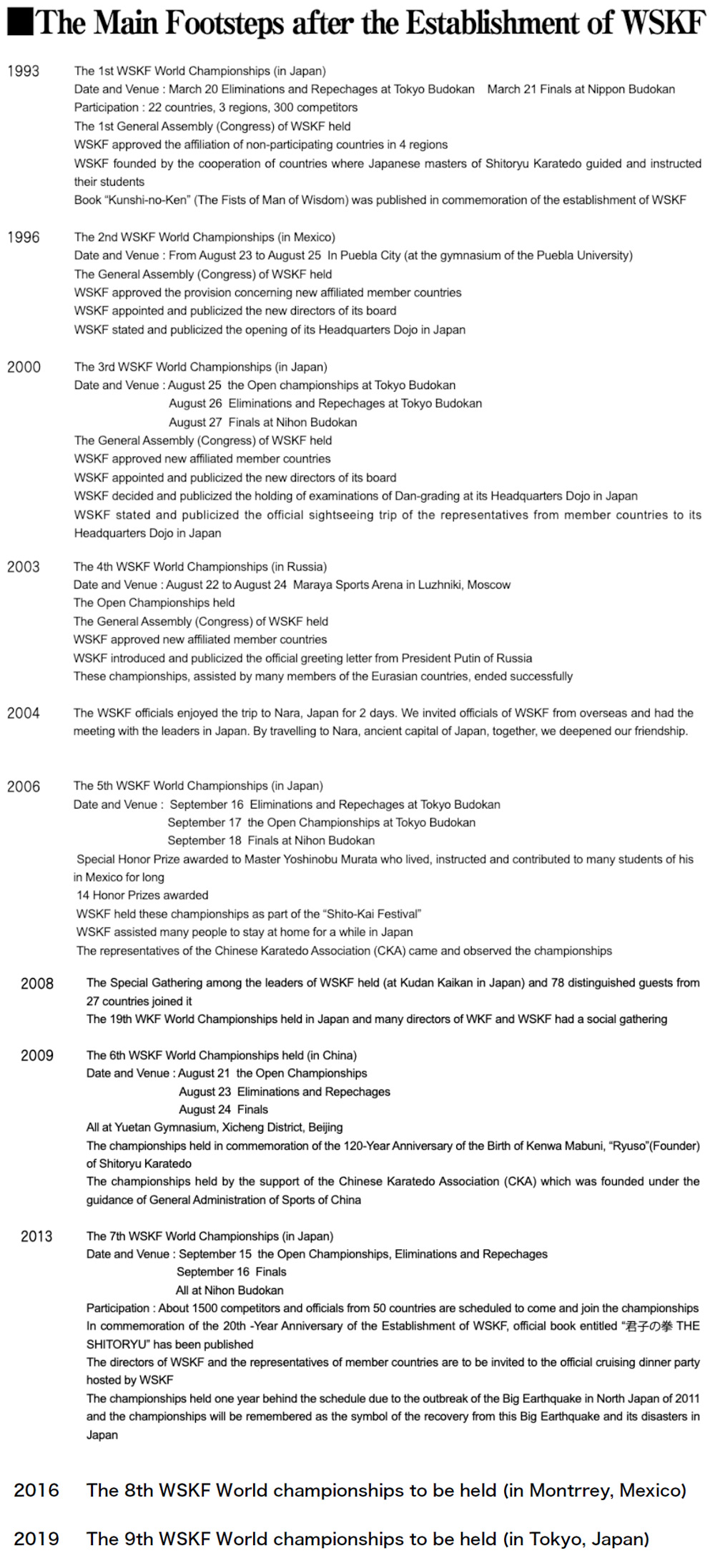The History of Shito-Kai
The Footsteps of “Ryuso” (Founder) Kenwa Mabuni
1.Brief Sketch of His Career
Sensei Kenwa Mabuni was born in Shuri City, Okinawa, on November 14, 1889. The origin of the Mabuni family comes from the name lord of the ancient Ryukyu Kingodom in Okinawa. There was a warlord called “0ni- Ohgushiku” in the old times. Sensei Kenwa Mabuni is one of his descendants, presumably the 17th generation grandson of this name warlord. Kenwa was a weak boy in his early childhood. Strangely he started feeling that he should be much stronger with sound and muscled body. Then he was allowed to enter the school of training when he was around 13 years old. He became one of the students of Master Anko Itosu who was living and teaching the martial art in Shuri City, Okinawa.
Graduating from his junior high school and the school of fisheries, he started teaching as an assistant teacher at Naha Elementary School for a while. He got acquainted with Sensei Chojun Miyagi, master of martial art and this acquaintance led him to Master Kanryo Higaonna who was versed in “Naha-Te” (Naha Karate).
After finishing his military service in 1914, he was recruited by the Naha Police Department and worked at the detective section for about 10 years. He had many opportunities of visiting local areas on job. It is how he met with the opportunities of learning Karate of “Arakaki” style, “boh-jutsu” (art of fighting with a cudgel), and “sai-jutsu” (art of fighting with metal truncheons) of “Tawata” style. They are parts of the old martial arts in Okinawa.
In May 1918, Kenwa Mabuni founded his “Karate Learning Group” and many trained practitioners of Karate gathered under him. In April 1921 he had the honor of demonstrating his art of Karate to the members for the Imperial Family of Japan when Princes (Kuni-nomiya and Kacho-no-miya) visited Okinawa. In 1924, he was asked to work as the teacher of Karate at Prefectural School of Fisheries and the training school for policemen. In the same year, he had another honor of demonstrating his art of Karate for the members of the Imperial Family of Japan when Princes (Chichibu-no-miya and Takamatsu-no-miya) visited Okinawa.
In April 1925, he established his Dojo at his house and founded the “Karate Learning Club”. Many leaders of Karate were there. You can name Chojun Miyagi, Juhatsu Kyoda, Choyu Motobu, Chomo Hanashiro, Chosho Ohgusuku, Choshin Chibana, and Go Kenki (Wu Xian Gui). In October 1926, Kenwa Mabuni had an extraordinary opportunity of meeting with Jigoro Kano, founder of modern Judo when he visited Okinawa. This founder of “Kodokan” Judo came and visited Okinawa for official speeches and for establishing the organization of Danholders of Judo in Okinawa. Sensei Mabuni and Sensei iyagi had the luxury of demonstrating and explaining about their art of Karate to this founder of Judo.
In 1929, Kenwa Mabuni moved to Osaka in the mainland Japan and he tried to popularize Karate (or Karatedo) among many universities in the western district of Japan. In 1931, he had the opportunity of demonstrating the art of Karate in the precinct of Sumiyoshi Shrine. In 1934, he established the “Yoshukan Karate Dojo”.
By then, many people knew and accepted the depth and the breadth of the knowledge and skills of Kenwa Mabuni. He was amazingly enthusiastic about accepting good elements of skills and techniques of Karate and studying the whole of its art by taking every new finding as part of good nourishment of his Karate style. In 1939, the “Shitoryu Karatedo” was founded. Kenwa Mabuni combined the features of Shuri Karate of Master Itosu and Naha Karate of Master Higaon-na. The name “Shito-ryu” (now Shitoryu) was formed from the first hieroglyphs of these Masters names (“ito” is “shi” and “higashi” is “to” in old Chinese hieroglyphs). In the same year, Kenwa Mabuni was awarded the honor of “Renshi” (the highest rank) of Karatedo from Dai Nippon Butoku- Kai.
Founder Kenwa Mabuni inherited the spirit of the Itosu style of Karate as its mainstream and tried to develop and popularize his “Shitoryu Karatedo” throughout his life.
He left his “tanka” (traditional Japanese poem) facing his death. It goes as follows:
“I have forgotten everything. It has been so pleasant to row a boat straight all along heading for the island of martial art”
He passed away at his own house on May 23, 1952 at the age of 62. His posthumous Buddhist name is “Yoshuin-Ken-Oh-Dogi-Kyoshi”.
2.The Way Kenwa Mabuni Learned Karate and How His Karate Paved Its Way
-Learning Karate from Sensei Anko Itosu, Kanryo Higaon-na and Yasukichi Arakaki
Kenwa Mabuni heard that a famous master of Karate was living in Shuri, Okinawa when he was about 13 years old. It was Sensei Anko Itosu. Through the introduction of his friend, he was allowed to learn under this master.
When Kenwa Mabuni was 20 years old, he started learning Karate under Sensei Kanryo Higaon-na through the introduction of Sensei Chojun Miyagi, his senior of Karate-learning. Under Sensei Higaon-na, Kenwa started learning “Shuri-Te” (Shuri Karate). Kenwa Mabuni and Chojun Miyagi were admired as two major and outstanding students of the school under Master Higaon-na.
When Sensei Mabuni was still working at the Police Station, he had many opportunities of visiting many places, and he learned many Kata and techniques other than “Shuri-Te” and “Naha-Te” under various Masters in local areas. At the same time, he learned “Saijutu” (the art of fighting with metal truncheon) under Sensei Shinpachi Tawada, and learned “Bojutsu of Soeishi style” under Sensei Soeishi, He also learned Karate and the traditional martial art such as “Bojutsu” (the art of fighting with a cudgel) under Sensei Arakaki ,
-Founder Kenwa Mabuni Established His Karate Learning Group
In 1918, Kenwa Mabuni established his Karate Learning Group. He had the honor of demonstrating the art of Karate in front of the Imperial Family of Japan (Princes Kuni-nomiya and Kacho-no-miya) when they visited Okinawa. In October 1925, his titanic effort to popularize Karate led him to the establishment of the “Okinawa Karate Learning Club”. It was the first Karate Dojo in Okinawa.
The leaders of this first Karate Dojo were Juhatsu Kyoda, Chojun Miyagi, Choyu Motobu, Chomo Hanashiro, Chosho Oshiro, Choshin Chibana, and Go Kenki (Wu Xian Gui), master of the Chinese-Kenpo (old martial art). In this Dojo, chief instructors were fairly young at age. They were Kenwa Mabuni and Chojun Miyagi.
-Kenwa Mabuni Demonstrated the Art of Karate to Jigoro Kano,Founder of Modern Judo in Japan, and then He
Moved to the Mainland Japan
In 1927, Kenwa Mabuni and Chojun Miyagi had the opportunity of demonstrating the art of Karate for Jigoro Kano, founder of modern Kodokan Judo, when he visited Okinawa. Looking at this demonstration, Sensei Kano, who was obviously astonished by the fine way of demonstration, said this. “This is good for both offense and defense. Why don’t you popularize it throughout Japan?” Hearing it, Kenwa Mabuni decided to move to the mainland Japan. It was in 1929.
-The Way Kenwa Mabuni Named His Style as “Shitoryu”
After moving to Osaka from Okinawa, Kenwa Mabuni established the Karate Learning Group in Kansai region (West Japan) . At the beginning, he named his style as “Gojuryu” and he was busy trying to popularize it. In 1934, however, he decided to rename his style of Karate as “Shitoryu”. This name was formed from the first hieroglyphs of two of his seniors--- Sensei Itosu and Sensei Higaon-na. It is how the name “Shitoryu” was born. In 1931, the Karate Learning Group in Kansai region was renamed as “Dai Nippon Karatedo Kai” (All Japan Karatedo Organization).
Then the art of Shitoryu began spreading among students of Karate all around Japan.
-The Only Martial Art that Survived the Prohibition Law of the Martial Arts in Japan Imposed by the Occupied US Army General Headquarters after the 2nd World War
When Japan surrendered to the United States in August 1945, everything changed. The US Army headquarters that occupied Japan then under the leadership of General MacArthur banned the practice of most of the old Japanese martial arts. The only one that survived is Karate. It was the only martial art that stayed as part of education in Japan. Then many Karate Clubs started activating among universities.
Those who mastered the martial arts in Japan, including Judo and Kendo, came and joined the practice of Karate. Thus Karate became the source of their mentality.
In 1934, Kenwa Mabuni renamed his Dojo in Osaka as “Yoshukan” after the name of the junior high school he graduated from. In 1950, US Army’s prohibition law of the Japanese martial arts was lifted and all these martial arts in Japan were reshaped and reorganized as modern sports.
Successors of the Founder (Brief Sketches of their Careers)
1.Sensei Ken-ei Mabuni
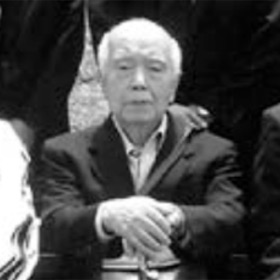
Career

-My Memories of My Father, Kenwa Mabuni
As far as I remember what was going on in my house in Okinawa in my childhood, I was starting to learn Karate by just watching people practicing it. There was a Dojo at the back of our house then. I witnessed many goods for training, such as sheaved straws, iron clogs, bellybands and sanders. Many students of my father were doing their practice there. It was the “Okinawa Karate Learning Club” itself and our house was its Dojo. In those days, the first priority of Karate was to build our own basic physical strength.
As for the skills and techniques, all the students of my father were trying to learn them by themselves by practicing Kumite. When they asked my father for guidance, he told them to come and fight with him. He said to them, “Come and do it with me”. My father was letting his students to do “Tsuki” (frontal thrust) and “Keri” (kicking) freely and it was his way of instructing them. It was the same with the way of his instructing Kata for his students. I guess that his students have found their own respective ways of understanding and interpreting what my father instructed them. How these students took what my father taught and instructed them was depending upon many different physiques, characters and ways of thinking of them. My father, Kenwa Mabuni, never forced any of his students to do this and that. He rather seemed to have enjoyed them learn more from what they individually tried to find for themselves.
I myself was never told to practice Karate by my father. Having two elder sisters, I might have been indulged in my childhood. It is true, however, that I started practicing Karate in a very natural way by myself.
After moving to Osaka from Okinawa, my father sometimes demonstrated Karate at the Dojo of the Police Station. When he demonstrated the breaking of roof tiles and boards, some called what my father did as the “Fist Dance”. So it was rather dangerous to show the power of Karate of this kind to the audience at the Police Station. Probably they might have thought that Karate is not suited for policemen. So it seemed quite difficult for my father to try to popularize Karate among people in those days.
I remember the strong wills and enthusiasm of the students who gathered around my father. I also remember how my father devoted almost half of his life to the development and popularization of Karate. These memories make me motivated even today. I strongly believe that it is my duty to pass on what my father found and created, namely, Shitoryu Karatedo itself, to the coming generation in good manners.
2.Sensei Manzo Iwata
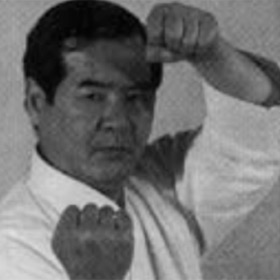
Career
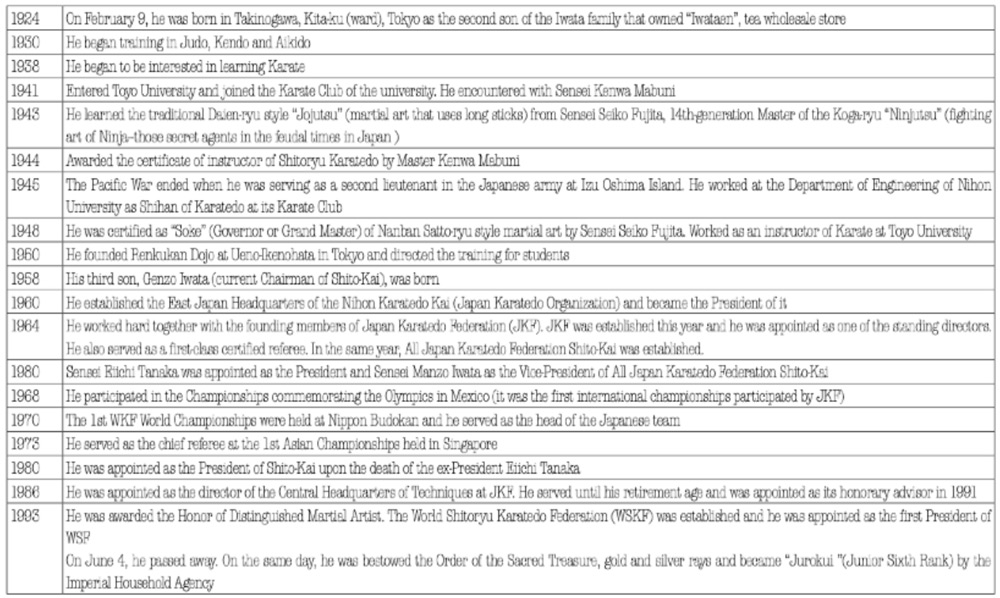
-My Recollection of Founder Kenwa Mabuni (excerpts from the book “Kunshi-no-Ken” – “Fists of Man of Virtue” )
The first thing I recall of Master Kenwa Mabuni is his gentle and modest character. In those days, it was hard to find an instructor like him. He was always modest in trying to learn whatever he did not know from anyone. He was always ready to obtain any knowledge to broaden his way of learning and thinking.
As a result, he was able to learn many Kata on one hand. On the other, he was always enthusiastic about pursuing something new. He was the first one to include “bunkai kumite”, which no other instructor of any style was trying to adopt, in his system of learning. He actually defined the meaning of each Kata and established the classic ways to make the most of each Kata. It was his way of transmitting everything he has learned to the coming younger generation.
Master Kenwa Mabuni was very vigorous and coherent in trying to teach us students the cores of Waza (skills) and Kata (forms). He thoroughly tried to teach us everything he has learned. He patiently waited until we could grasp the essence of this art. He was always coherent in his way of teaching us the differences and the features of Itosu style and Higaonna style. He was not adding anything new to what he has learned. He was stubborn in teaching us the traditional classic Waza (skills).
At the same time, Master Mabuni urged me to absorb a lot of knowledge and skills and kindly introduced me to Master Seiko Fujita, one of Master Mabuni’s friends and master of many traditional Japanese martial arts, to learn something more. Everything I learned under Master Fujita is valuable for me and my life. Now I feel so indebted and thankful for what Master Mabuni suggested me to try doing.
Now I know that the core of Master Mabuni’s heart is being inherited among us as refined and sophisticated skills of Shitoryu. When I recall Master Mabuni, I cannot help but truthfully get to know the importance of transmitting and telling the classic cores of Shitoryu Karatedo to the coming generations.
3.Sensei Yoshiaki Tsujikawa
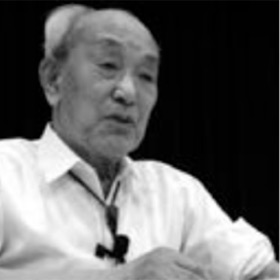
Career
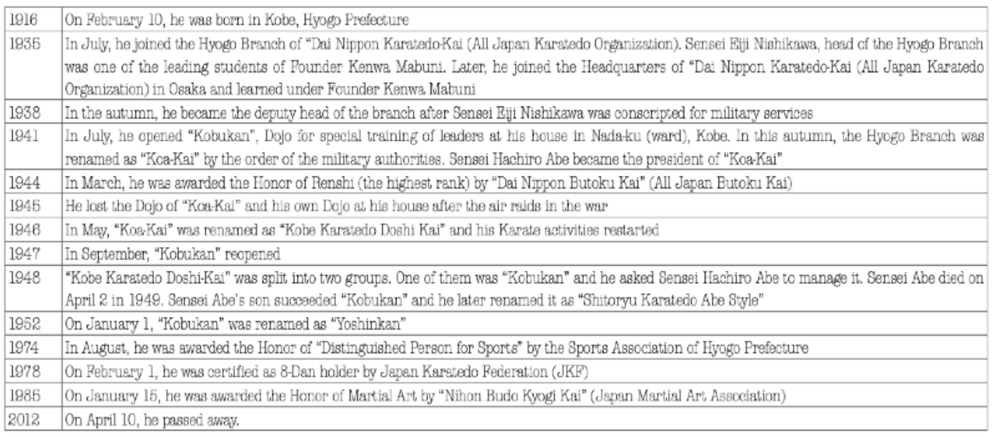
-My Recollection of Founder Kenwa Mabuni (excerpts from the book “Kunshi-no-Ken” – “Fists of Man of Virtue” )
As I recall the days of training at the Headquarters Dojo of Dai Nippon Karatedo Kai (All Japan Karatedo Organization), in around 1937 and 1938, I remember almost everything as if it happened yesterday. Master Kenwa Mabuni, with his gentle look sitting at the center of Dojo, I remember his students were urrounding him. Sensei Takamasa Tomoyori who was good at techniques, Sensei Yoshikatsu Hase who was good at theories, Sensei Miura who was good at showing strength and many other students were all there surrounding our Founder.
In those days, the way of practice was mainly based on Kihon ( fundamentals) and Kata. Kumite was mainly focused on “Bunkai Kumite”, its applied Kumite and “Kenkyu (studying) Kumite”. ‘Jiyu Free” (free kumite) of today was only practiced on special occasions. The training was rough and hard. “Tukigeri”(frontal thrust and kicking) was actually daily practice. Likewise, “Nagewaza” and “Gyakuwaza” were daily routines. The “Do-I” (Karate wear) was not as fashionable as that of today. We were using Kendo’s quilted jacket and Judo’s underpants. Since our “Keiko” (practice) was quite rough in manners, our wears used to get torn apart quite often. In those days, the way Master Kenwa Mabuni taught us was quite rough, not like those we found so gentle and mild in manners at his later days.
And we were following our Master the ways we could.
Master Kenwa Mabuni was trying to contribute himself for the recovery and re-building of Japan. He lived his humble days and survived poverty throughout those difficult days. He was trying his best to popularize Shitoryu Karatedo around Japan. It is too bad that he passed away all of sudden on May 23, 1952. I can imagine how sad he might have been not to see what he was aiming at come true.
I remember very clearly that all of us students of Founder Kenwa Mabuni, vowed to inherit his will and dream and make them come true. I remember it like it happened only yesterday.
4.Sensei Ken Sakio
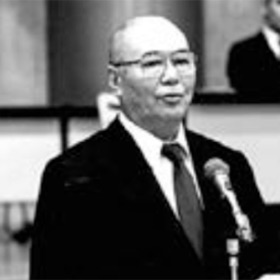
Career
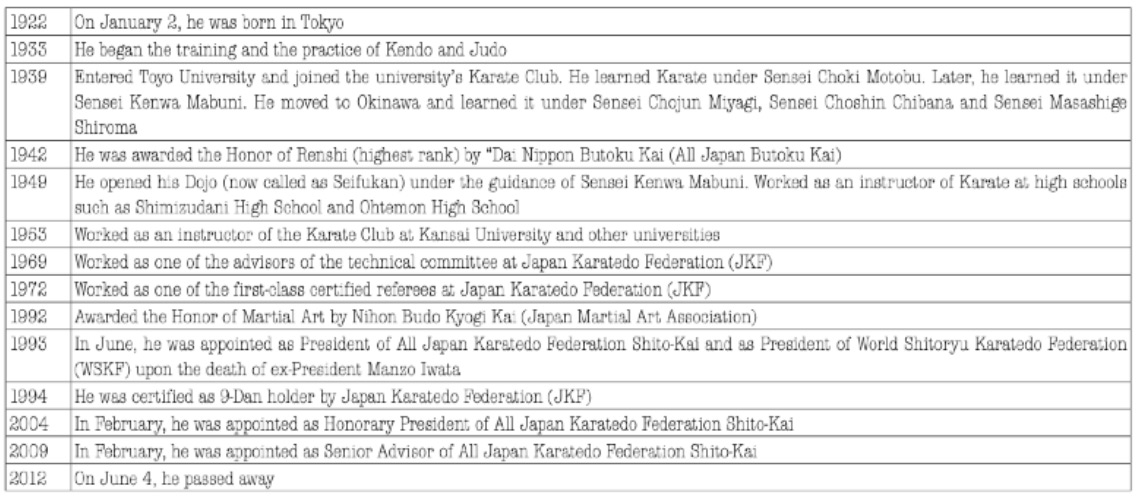
-My Recollection of Founder Kenwa Mabuni (excerpts from the book “Kunshi-no-Ken” -“Fists of Man of Virtue” )
The first time I met with Master Kenwa Mabuni was in July 1939. It was when I visited our Founder of Shitoryu Karatedo in Okinawa to receive letters of introduction for learning Karate under Sensei Miyagi, Chibana and Shiroma.
In those days, I was learning at the Karate Club of Toyo University under Sensei Choki Motobu. After Sensei Motobu left our university for Okinawa (it was his retirement), I had no other choice and decided to come and visit Master Kenwa Mabuni in Okinawa for a help. I was young and rude enough to ask him for a favor.
Master Kenwa Mabuni, looking at and talking with me, who was a sheer student, was generous enough to take good care of me. He kindly gave me letters of introduction and some pieces of advice. It was this coincidence that gave me the opportunity of learning under Master Mabuni in later days.
It was the time just a little before the outbreak of the Pacific War in December, 1941. All of us were not sure what would happen to us then. I was charmed by the character of Master Kenwa Mabuni and the art of Karate itself in such a situation. Then I devoted myself to learning Karate under Master Mabuni until I was conscripted in April, 1943. In this short period of time, I remember that I tried to learn as much as I could. I was in practice days and nights. I was commuting to Master’s Dojo with my lunch box and I was careless enough to miss the last train to go back to my pad at night. Recalling those days, I do feel extremely thankful to Master Mabuni, his wife and their son, Kenzo Mabuni who took good care of me. At the same time, I do feel sorry that I have caused them a lot of troubles.
Master Mabuni was 50 years old then. I guess that he may have reached the climax of his learning the essence of what he was seeking. His way of instructing was almost perfect and I was astonished. I was barely trying to catch up with him. I remember that I was surprised to see Master Mabuni trying to look for something beyond my comprehension. He was trying to reach the essence of Karatedo.
The war ended. I was not able to absorb and digest what Master Mabuni taught me then. 50 years have elapsed since then. Now I feel ashamed that I still emain immature in learning the essence of the art of Karatedo.
The Footsteps of Shito-Kai
1.From Japan Karatedo Kai to Shito-Kai in the East and the West of Japan and eventually to the present Shito-Kai
-From Japan Karatedo Kai to Shito-Kai in the East and the West of Japan
The “Dai Nippon Karatedo Kai” (All Japan Karatedo Organization) established by Founder Kenwa Mabuni in 1931 was renamed as the “Nippon Karatedo Kai” (Japan Karatedo Organization) later.
On May 23, 1952, Founder Kenwa Mabuni passed away. He was convinced that what he achieved and created, that is, Shitoryu Karatedo, would be succeeded by his followers and would be popularized much more in later days. As the Founder envisaged in his mind, his students and followers have devoted themselves to the development and popularization of Shitoryu and Shito-Kai.
In the chaotic and devastated situations of the pre-war (the Second World War) and the postwar period, those students who learned directly under Founder Kenwa Mabuni established “Nihon Karatedo Kai” (Japan Karatedo Organization), that is, today’s Shito-Kai. They were so enthusiastic and active in protecting what their master, Kenwa Mabuni, found and created. They have never forgotten to inherit what they learned from Founder Kenwa Mabuni. Their spirits are still active in today’s “All Japan Karatedo Shito-Kai”.
-The Establishment of the Headquarters of the East and the West Regions in 1960
The mainstream of Shitoryu Karatedo was active in the West region in Japan for a while. And on November 1, 1960, Shitoryu’s East headquarters were stablished in the East region of Japan. Sensei Manzo Iwata, ex-president of Shito-Kai, was the leader of this new organization. Around the same time, the West headquarters were also established. Sensei Manzo Iwata led the East headquarters and Sensei Ken-ei Mabuni (son of Founder Kenwa Mabuni) led the West headquarters as its respective president.
-In 1964, All Japan Karatedo Federation Shito-Kai was Established
In April, 1964, the united championships of the East and West headquarters were held. Till then, each of these two headquarters was holding their own ndependent and respective championships.
In such moves, many leaders of Shitoryu Karatedo gathered to work out ways of uniting and acting together at these united championships. Among them, we can witness the following leaders---Kaoru Kaiho, Manzo Iwata, Shiro Ito from the East headquarters and Haruji Takamaru, Yoshiaki Tsujikawa, Ken Sakio from the West headquarters. When they reached an agreement for unification, they renamed the organization as “All Japan Karatedo Shito-Kai”.
It is important to know that Japan Karatedo Federation (JKF) was established on October 1 of the same year (1964). The time of unification arrived and the people of Shitoryu Karatedo finally established “All Japan Karatedo Federation Shito-Kai”.
One seed sown and planted in the mainland of Japan by Founder Kenwa Mabuni a long time ago finally has sprung. It has come a long way by changing the names of organizations. It has grown bigger and made it sure to grow outside of Japan, too.
We now know that this one seed sown by the Founder of Shitoryu Karatedo is blossoming all over now.
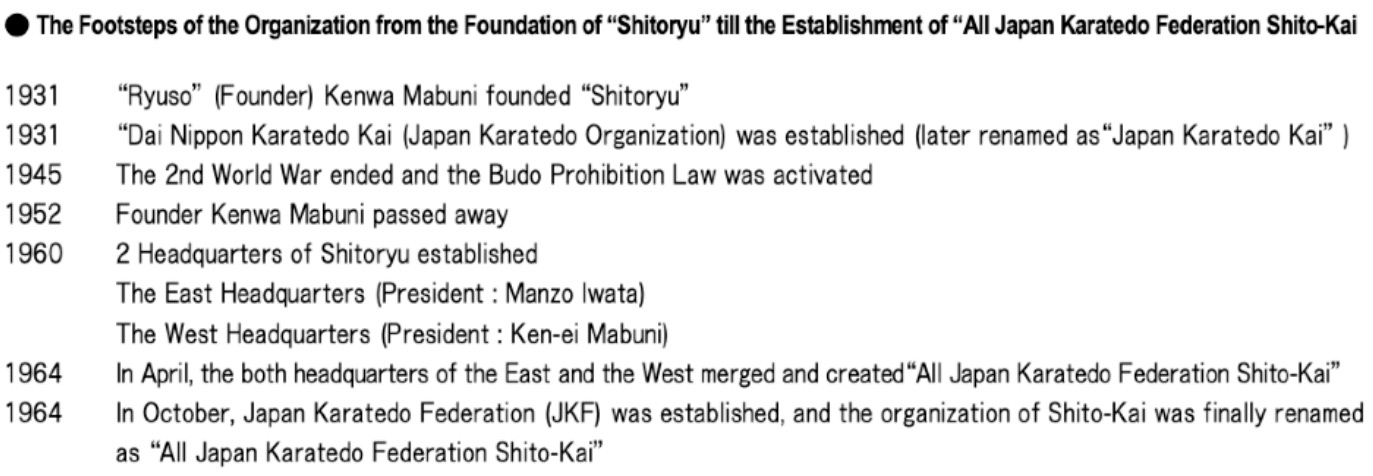
2.The Popularization of the Organizations around the World
-The Growth of the Organization - collecting important information from many concerned people who were involved with Shitoryu Karatedo
After the establishment of “All Japan Karatedo Federation Shito-Kai” in 1964, many concerned people of Shito-Kai started trying to systematize the basic requirements of the organization itself. Many opinions arose and many actions for the trials for change were taken.
One example is the making of new regulations for the leaders of the organization. After the making of the guideline for the leaders of Shitoryu Karatedo in 1973, one important rule, that is, “only those who hold the qualification above 5th Dan to be called as Shihan”, many trials for finding new ways for its systematization have started. And many new organizations were established around Japan.
This move for the systematization of Shito-Kai as a global organization reached many areas outside of Japan as well. After the training journey to the Central American region by the leaders of Shito-Kai in 1950s, Shitoryu Karatedo began to expand among the learners in many countries. This move overcame the barrier of different languages and lifestyles. In 1978, “Asia Shitoryu Karatedo Federation” was established. Many other regional organizations began their own activities and they started to establish their own official organizations affiliated with Shito- Kai of Japan.
In 1990s, many people started requesting the headquarters of Shito-Kai to hold international championships of Shitoryu Karatedo. It was natural that they wished to establish one united international organization that can make it possible to hold such championships. On March 17, 1993, World Shitoryu Karatedo Federation (WSKF) was established at long last. On March 21 of the same year, the 1st WSKF World Championships were held.
-The Establishment of the World Headquarters and Its Committees
The systematization process of Shito-Kai has been speeded up in Japan as well as outside the country. Many voices and reflections on how the 1st WSKF Championships were held reached some conclusions. These conclusions gave the organization the motivation to move forward for the better. Then the leaders of Shito-Kai decided to establish new systems and ways for the headquarters and the committees to act more efficiently. It was the first step forward of this kind. In 1995, the board of directors with its chairman and vice-chairman started its activities as the most powerful decision-making body. In this way, many new ways of building better regulations were available within Shito-Kai and the leaders took appropriate actions for a better systematization of the organization. Then the powerful central decision-making body of the organization succeeded in maintaining its stable position. In the same year, many local bodies were established in Japan. Many local headquarters were established and their affiliated organizations in many prefectures around Japan began to start their own activities.
-The Honbu (Headquarters) Dojo Established in 1997
On April 12, 1997, the Headquarters Dojo was established in Asaka City, Saitama Prefecture, Japan. This Dojo is the place where many learners of Shitoryu Karatedo wish to come and visit for practice. Moreover, it is the center of their learning and training of mind and body. Luckily the making of the Headquarters Dojo has led many people to many seminars and trainings. It has helped many learners, including younger generations of Shitoryu Karatedo, upgrade their skills and techniques. It also has helped grow many leaders, such as the powerful competitors of the national team of Shito-Kai.
At the same time, the Headquarters Dojo started its own activities of welcoming many learners from outside of Japan for trainings and seminars. It has established the new way of exporting its traditional skills and techniques of Shito-Kai to many countries. It has published the guidebooks of united Kata, videotapes of Kata and others. It was important for the organization to tell and teach the good traditional skills and techniques of Shitoryu Karatedo to all learners outside of Japan.
-Going Ahead at the Forefront of the Time
It is the tradition of Shito-Kai to look for something new for improvement. It is the legacy from our Founder (Kenwa Mabuni) and his followers. In the autumn of 1993, Shito-Kai decided to give more efforts for further education of learners. It needed to educate young competitors and athletes for the coming future. It was clearly stated and publicized in the medium and long term plans of Shito-Kai. It is stated that Shito-Kai should educate people who can inherit the traditional skills and techniques of Shitoryu Karatedo. It also stated that Shito-Kai should educate as many people as possible who can contribute to the development of Shito-Kai in the future.
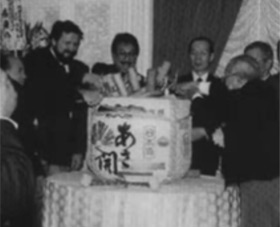
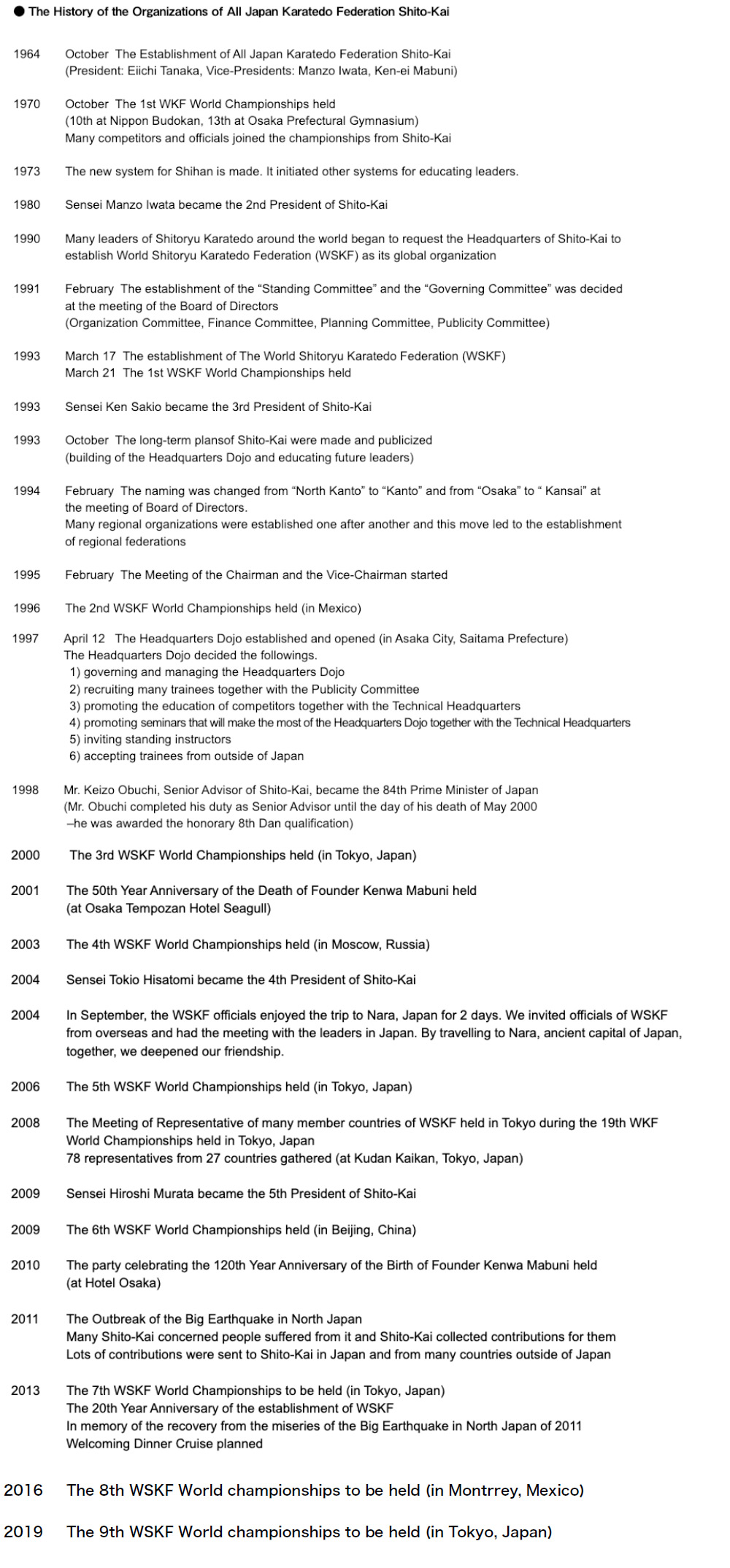
World Shitoryu Karatedo Federation (WSKF)
1.The History of Its Foundation
The History of the Foundation of World Shitoryu Karatedo Federation (WSKF)
The history of vigorous teaching and instructing activities carried out by many grand masters of Shitoryu Karatedo outside of Japan is quite long. It started with the instructing and training activities done by Sensei Nobuyoshi Murata in Mexico. Since then, many masters were sent abroad from Japan for further training during 1960s and 1970s. It was a series of planned dispatch of masters and instructors of Shitoryu Karatedo outside of Japan.
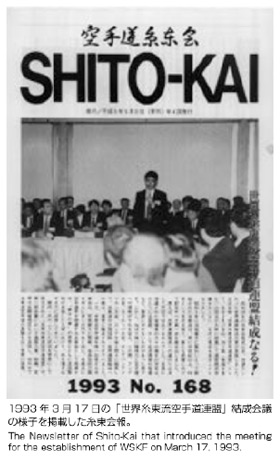
Before introducing how WSKF has developed, let us explain how Shito- Kai made its history inside Japan. In 1960, the headquarters of the East Japan of All Japan Karatedo-Kai were founded. The headquarters of the West Japan were also founded around the same time. Sensei Manzo Iwata became the president of the headquarters of the East Japan of All Japan Karatedo-Kai and Sensei Ken-ei Mabuni, son of Founder Kenwa Mabuni, became the president of the headquarters of the West Japan of the same organization. In 1964, All Japan Shitoryu Karatedo Championships were held by combining these two headquarters. In the same year, Japan Karatedo Federation (JKF) was founded. Four big styles of Karatedo were the major members of JKF then. All Japan Karatedo Federation Shito-Kai of today was one of them.
By then, many seminars for training leaders and examinations for Dan- grading were held outside of Japan. At the same time, many Shitoryu Karatedo organizations were beginning to be established in many countries around theworld. It was natural that many big championships of Shitoryu Karatedo were held in various countries. Many regional organizations were established and many regional championships were held. The center of the Pan-American region was Mexico, and that of the Asian-Pacific region was Singapore, that of the Russian-Eurasian region was Russia and those of the European region were Spain and France. The expectation of the establishment of the world federation of Shitoryu Karatedo was growing bigger and bigger.
In 1993, the decision of the establishment of such a world federation was finally made. It was agreed and supported by many leaders and students of Shitoryu Karatedo to convey and teach the great teachings of Kenwa Mabuni, “Ryuso” (Founder) of Shitoryu Karatedo around the world. World Shitoryu Karatedo Federation (WSKF) was founded at long last to convey and develop the lofty ideal and philosophy of the Founder of Shitoryu Karatedo.
WSKF has helped its affiliated organizations and members outside of Japan receive its assistance in technical guidance and holding championships. At the same time, WSKF has offered these affiliated organizations and members the opportunity of coming to Japan and learn through its seminars and trainings at its Headquarters Dojo. WSKF and its affiliated organizations and members have come a long way hand in hand and have deepened strong mutual ties till today. Its World Championships have been held once in every three years (championships in Japan to be held in every odd year).
In next page, you can see the history of WSKF from its foundation till today. In there, you can find the information about the championships held and the host countries that sustained these championships.
